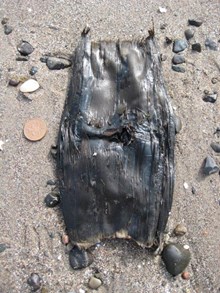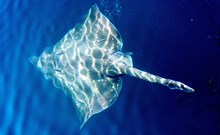14 July, 2015
Call for summer beachcombers to hunt for skate egg cases
Walkers, divers and fishermen in Argyll are being asked to report sightings of common skate egg cases, to help Scottish Natural Heritage (SNH) learn more about where the huge fish are breeding.
The call for information comes after a Marine Protected Area (MPA) for common skate was put in place last year between Loch Sunart and the Sound of Jura. The west coast of Scotland and Orkney appear to be the last strongholds for the critically endangered fish in the UK.
As its name suggests, the common skate was once widely distributed and was an important part of the inshore commercial fishery. However the numbers of skate have fallen dramatically in most coastal areas of the UK and it is now classed as critically endangered.
Living in deep, dark water, common skate grow to up to 3m in length, live for up to 100 years and weigh over 15 stone. They are the largest species of skate in Europe and research shows that although most fish move only small distances, they can swim for more than 200 km.
Like some other sharks, skates and rays, common skate reproduce by laying tough, leathery egg cases on the seabed which often become trapped between rocks by the curved ‘horns’ at the corners of the case. Each egg case holds a tiny embryo which develops over several months into a miniature skate. Once the tiny fish has hatched, the egg case, also known as a mermaid’s purse, often washes ashore on nearby beaches.
Jane Dodd, SNH marine operations officer said: “We’d like everyone in Argyll to look out for skate egg cases, particularly people going to the beach over the summer holidays. And if you are a diver and remember seeing them on a dive please scour your log book and let us know where, when and how many you saw - even if you can only give us approximate dates and locations this might help us solve the mystery of when and where skate lay their eggs.
“Common skate egg cases are the largest egg cases you are likely to find - and the rarest. They are about the size of an A4 sheet of paper - roughly 30cm long and 15cm across - with short slightly curved “horns” at the corners, so they are easy to distinguish from other shark and ray egg cases which are much smaller. Newly hatched egg cases are olive green and leathery and older ones are black but if they have dried in the strandline, which is probably the best place to look for them, they can have a coating of brown, papery, bark-like material. For more information about what to look for join the Shark Trust Great Eggcase Hunt at http://www.eggcase.org. It will help you identify any egg cases you find.
“Please take away any skate egg cases you find on the beach so they won’t be reported again by someone else and email us at skate@snh.gov.uk with the location, date and time you found them. If you can attach a photo of the egg case as well, with a ruler or a 2 pence piece for scale, that would be great. You can also ring me at the SNH office in Oban on 0300 244 9360. We will forward on any sightings of common skate egg cases to the Shark Trust. Any other shark or ray egg cases you find can be reported straight to the Shark Trust Great Eggcase Hunt.”
ENDS
For media enquiries contact Nancy Fraser, SNH media & public relations officer on 0141 951 0809 / 0141 951 4488 or nancy.fraser@snh.gov.uk
Tag and release data provided by anglers, along with other data collected by Marine Scotland, showed that the Loch Sunart to the Sound of Jura Marine Protected Area (MPA) is home to between 100 and 400 skate. Some of them have been tagged and recaptured in the area several times suggesting they stay in and around the MPA all year round.
In 2009 scientists discovered that the species previously referred to as “common skate” are actually two distinct species - the flapper skate and the blue skate. They are very difficult to tell apart. It is thought that flapper skate live in the Loch Sunart to the Sound of Jura area but DNA testing of fin clips taken when the giant fish are tagged will hopefully prove for certain which species live there and how the two are related.
The common skate is a member of the shark family so it does not have bones, but a cartilaginous skeleton like human noses and ears.
It is no longer legal for fishermen to land common skate to eat but their size and bottom-dwelling habits make them vulnerable to being caught accidentally in dredges and trawls. Angling for skate is allowed as long as the fish are returned to the sea after they are caught. The tag and release data provided by anglers will continue to be valuable for monitoring the MPA.
Loch Sunart to the Sound of Jura is the only MPA for skate in Scotland. For more information, go to http://www.snh.gov.uk/docs/A978503.pdf. It is part of a network of MPAs in Scottish waters, protecting marine wildlife, habitats and undersea landscapes from the coast to 200 nautical miles offshore. For more information on Marine Protected Areas go to http://www.snh.gov.uk/protecting-scotlands-nature/protected-areas/national-designations/marine-protected-areas-(mpa)/.
Contact information
- Name
- SNH Media
- snhmedia@snh.gov.uk
NatureScot is Scotland's nature agency. We work to enhance our natural environment in Scotland and inspire everyone to care more about it. Our priority is a nature-rich future for Scotland and an effective response to the climate emergency. For more information, visit our website at www.nature.scot or follow us on X at https://x.com/NatureScot
’S e NatureScot buidheann nàdair na h-Alba. Bidh sinn a’ neartachadh àrainneachd na h-Alba agus a’ brosnachadh dhaoine gu barrachd suim a chur ann an nàdar. Tha e mar phrìomhachas againn gum bi nàdar na h-Alba beairteach agus gun dèilig sinn gu h-èifeachdach le èiginn na gnàth-shìde. Tha an tuilleadh fiosrachaidh aig www.nature.scot no air X aig https://x.com/NatureScot


